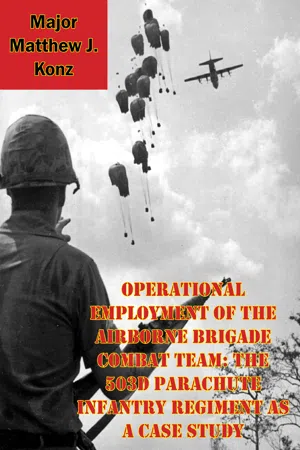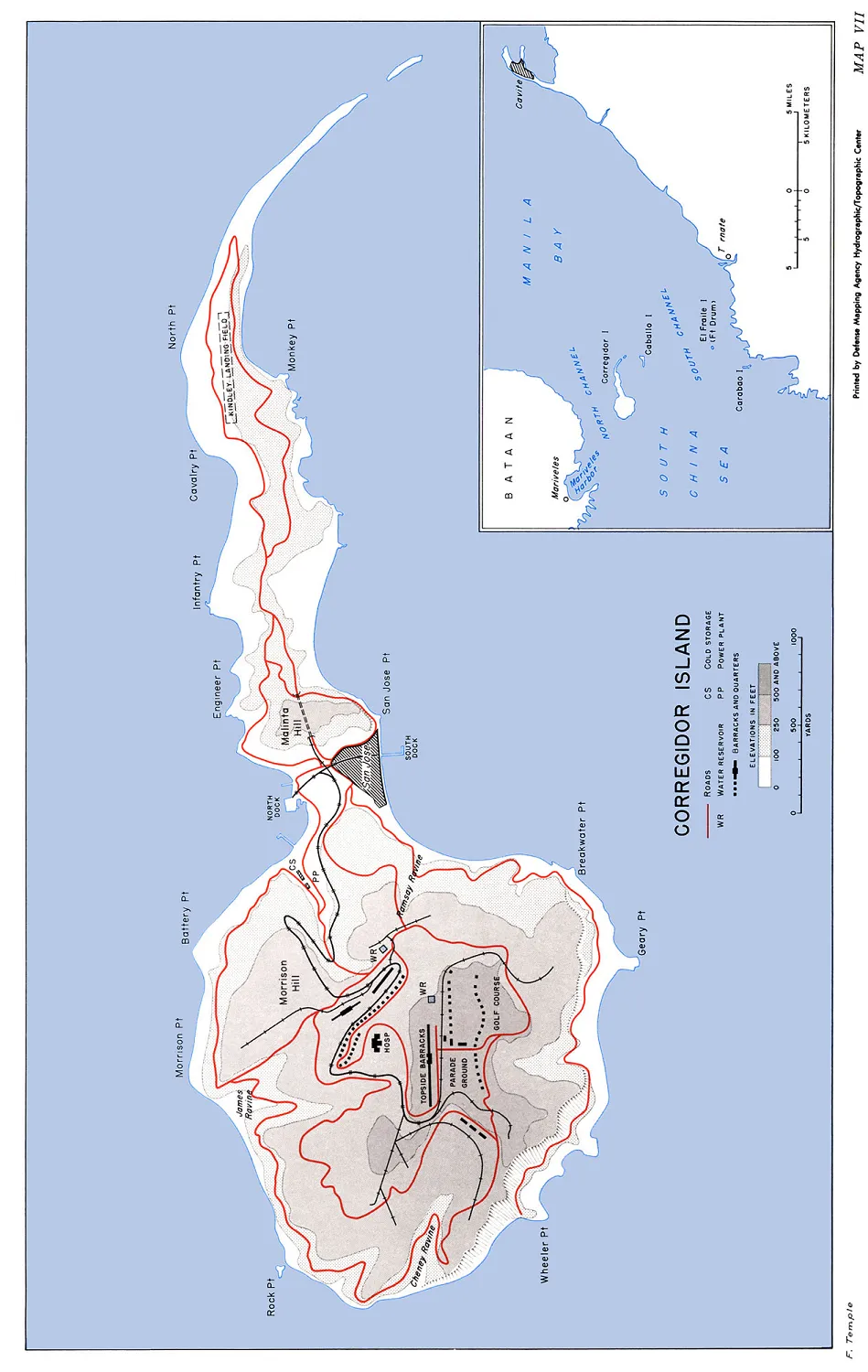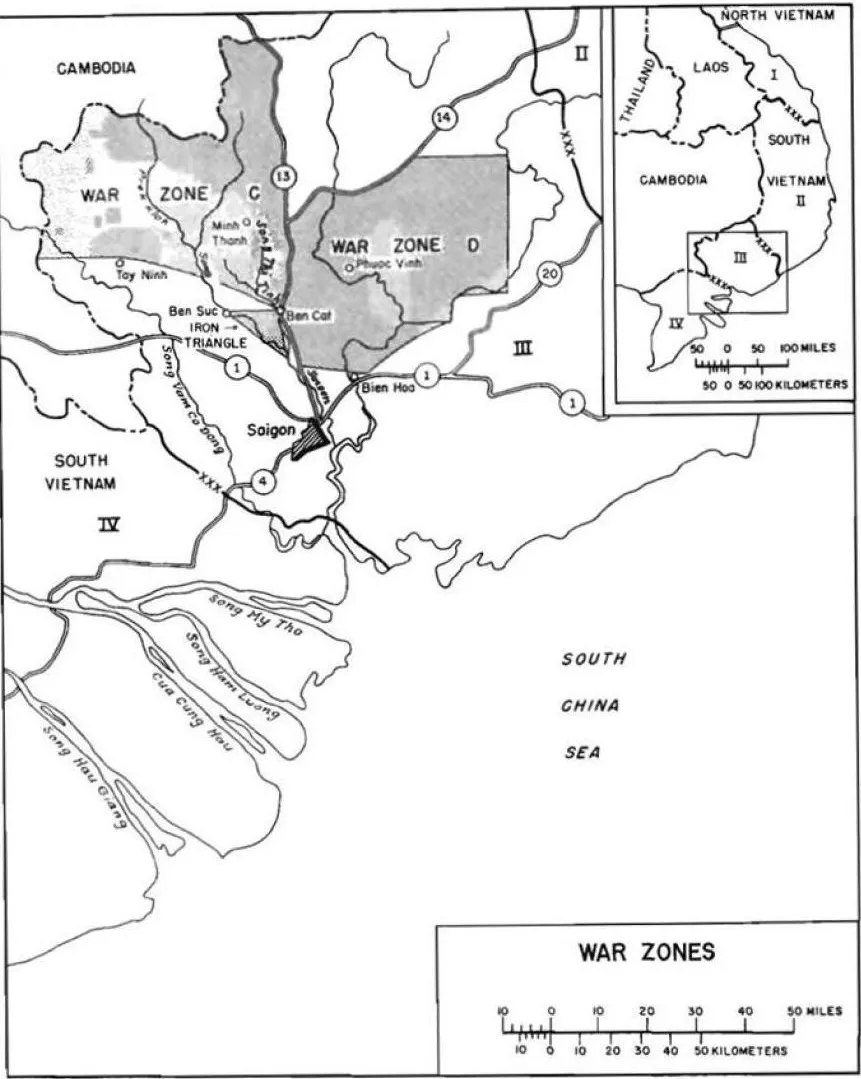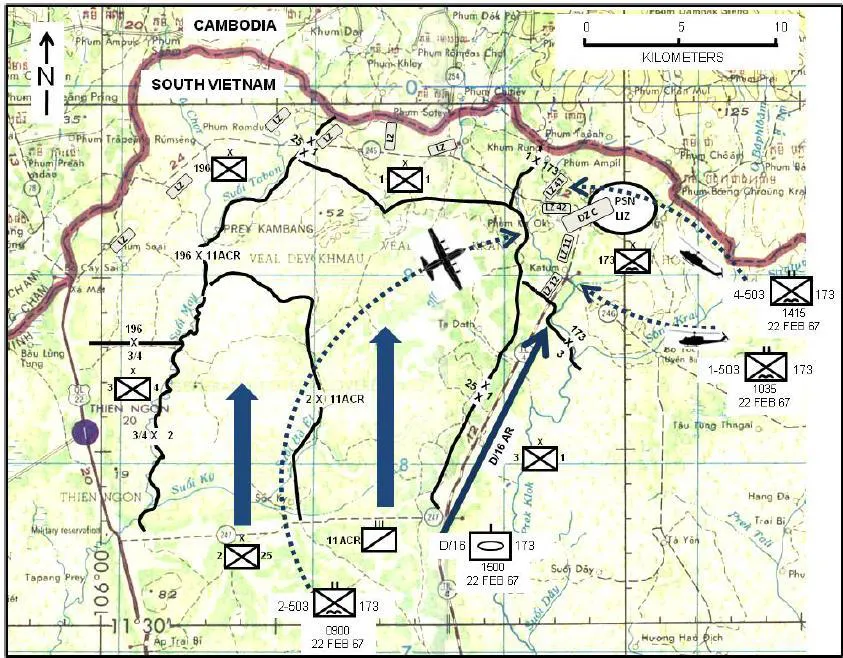![]()
APPENDIX 1—REVIEW OF CURRENT AIRBORNE DOCTRINE
Current U.S. Army doctrine as discussed in FM 90-26, lists several fundamentals and characteristics of airborne operations. Airborne operations are characterized by complexity, joint operations, a planned link-up with follow-on forces, a robust, flexible command and control with emphasis on mission-type orders, detailed and well understood Standing Operating Procedures (SOP), and aggressive, rapid seizure of the assault objective(s).{290} Airborne operations require centralized, detailed planning with aggressive decentralized execution, adhere to the principle of simplicity and typically use a four phase “reverse planning sequence.”{291} The four phases are the ground tactical plan, the landing plan, the air movement plan, and the marshalling plan. While the plan will be executed chronologically from the marshalling area to the objective, the planning process is conducted in reverse, from the objective areas back to the departure airfields. Each phase is planned in extreme detail to ensure the entire operation has the best possible chance of success, and that each phase fully supports the phase that follows.
Remembering that a parachute is just a way to get to the objective, actions on the objective must be first considered. The ground tactical plan serves as the foundation of a successful airborne operation and must drive all other planning. All subsequent planning is based on the planned actions on the ground by the assault forces and the subsequent operations. The ground tactical plan contains the same elements of any other infantry operation, but capitalizes on the elements of surprise and speed to rapidly build up combat power.{292}
A drop zone is simply an area designated by the ground unit commander where personnel and equipment are delivered by means of a parachute.{293} In an optimal situation, the ground tactical plan will normally dictate the number and location of drop zones as well as the sequencing of troops into the objective area. However, reality often interrupts the ideal. The number of available options for the ground scheme of maneuver are usually limited by the number, size or location of open areas suitable for use as drop zones.
Paratroopers are most vulnerable during the actual paradrop and assembly on the ground, therefore the Landing Plan is very detailed and must be well understood by all paratroopers and aircrews. Aspects of the plan must include aircraft airspeed, altitude and direction for flight over the drop zone. Very slow drop speeds increase the risk of an aircraft stalling and increases vulnerability of aircraft to ground fire. A high airdrop speed will result in fewer jumpers being able to exit on a given drop zone, jumpers becoming more dispersed, and increases the opening shock felt by the jumper when the parachute deploys. Also, high airdrop speeds often result in damaged parachute canopies as panels are ‘blown out’ due to the violent opening caused by the high speed.
Drop altitude is also carefully considered. Higher altitudes may make the drop aircraft more vulnerable to ground fire and air defense systems. High drop altitudes increase the vulnerability of jumpers to ground fire as they take more time to descend, while low altitudes may not provide enough time for the parachute to fully deploy and slow a jumper’s rate of decent.
Suitable weather conditions are a critical condition for an airborne operation. High winds will cause jumpers to drift off the drop zone and land in trees or other hazards. Also, high winds increase the speed of lateral drift of a jumper on landing, causing a very hard landing and increased chance of injury. Hazards on and around a drop zone may significantly increase the risk of an airborne drop, or make it entirely unfeasible. For example, jumpers injured when landing into tall trees, power lines or large craters or jumpers drowning in water could cause so many casualties that the airborne force becomes ineffective before it gets off the drop zone. Commanders of airborne forces must carefully weigh the risks and make crucial decisions on how to mitigate these risks or to change or cancel a mission entirely.
Drop zones directly on top of the objective allow for the most surprise and rapid accomplishment of immediate mission, but will often expose troopers to intense hostile fire and increases risk of the airborne force of being isolated. Landing away from the objective and conducting a foot movement may be required when drop zone availability or the enemy situation requires it, yet may achieve the least amount of surprise. Also, landing away from an objective may make it difficult for troops to orient themselves to the terrain. Regardless of drop zone location, it is always difficult for units to re-assemble after soldiers and equipment are scattered across a vast area, especially at night. Well prepared plans and well-rehearsed standing operating procedures conducted by trained, disciplined and fit soldiers are critical to minimize the inevitable confusion immediately following a drop.
The Air Movement Plan ensures the airborne unit get to the assigned drop zones and objectives at the assigned times with all available support, particularly supporting fires. The Marshalling Plan ensures that the correct personnel and equipment is secure, assembled, prepared and loaded onto the correct aircraft as per the ground tactical plan. Both of these phases sound simple in concept. In reality, the success or failure of a mission may occur based on the plans during these phases. For example, units are frequently split up and dispersed on different aircraft. This is done for several reasons. First is a concept called tactical “cross-leveling.” For example, a unit will not place all key leaders or all items of critical equipment on a single aircraft. This is done in the event an aircraft becomes lost, shot down, or drops the troops in the wrong location, at least some leaders and critical equipment will still likely make it to the objective. A second reason a unit is split up on different aircraft is to be able to facilitate assembly and actions on assigned objectives. For example, a single C-130 aircraft dropping 60 soldiers from both troop doors will scatter the jumpers in a single line 2250 yards long. If a single unit placed all its troops on that aircraft, and that unit’s objective is near the trail edge of the drop zone, then there would be soldiers who would need to walk the entire length of the drop zone. If multiple units are conducting an airborne assault, they then can load each aircraft in a manner that will allow the soldiers to jump in a position that will allow them to land as close as possible to each objective, such as an objective on each end of the drop zone. What is most critical to understand about this cross leveling is the fact that after a unit arrives at the marshalling area and the jumpers are assigned to aircraft, there is virtually no way to re-assemble the unit to issue new guidance or make several, rapid changes to the plan. Contrast this to a mechanized unit where every vehicle has a radio and orders can be rapidly disseminated, even after the unit leaves its planning base or assembly area. Throughout the discussion of the airborne operations, it is important to understand these inherent risks of the landing phase of an operation. As a point of comparison when studying an airborne plan, a typical plan for a peacetime training airborne operation based on current doctrinal procedures follows: The maximum surface wind speed to conduct a training jump is 13 knots (15 MPH).{294} The planning airdrop airspeed for a single C-130 is 130 knots (150 MPH){295} with a drop altitude of 800 feet.{296} This aircraft with 62 combat equipped jumpers will require a minimum un-waivered drop zone of 600 yards wide and 2125 yards long, requiring 43 seconds for all jumpers to exit in a single pass.{297} Time of decent for the jumpers is approximately 40 seconds.{298}
![]()
APPENDIX 2—MAPS
The 503d Parachute Infantry Regiment Retakes Corregidor Island: 16 February 1944
Figure 1. Corregidor Island.
Source: Smith, Robert R. U.S. Army in World War II-The War in the Pacific: Triumph in the Philippines. Washington, DC: Center for Military History, 1993.
![]()
The 173d Airborne Brigade (Separate) in Operation Junction City: 22 February 1967.
Figure 5. War Zone C.
Source: Rogers, Major Gen. Bernard W. CMH Pub 90-7-1 Vietnam Studies Cedar Falls-Junction City: A Turning Point. Washington, DC: Center for Military History, 1974, 8.
![]()
Figure 6. Air Movement of the 173d Airborne Brigade (Separate): 22 February 1967.
![]()
Figure 7. II Field Force Plan of Operations for Operation Junction City II.{299}
2323__perle...



